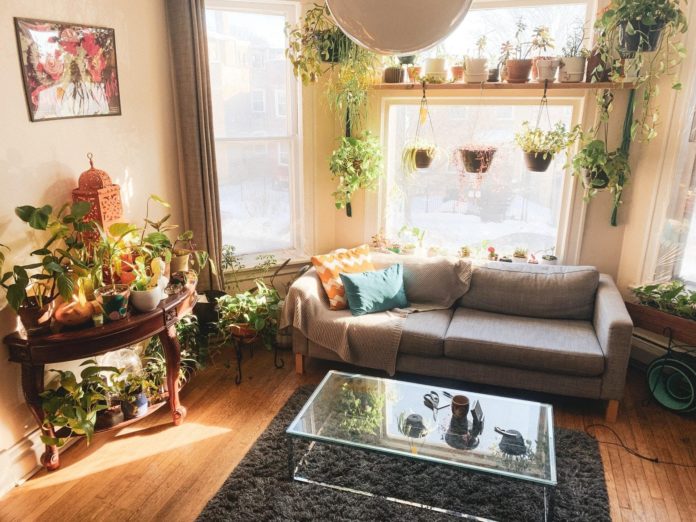Although some plants like snake plant, bird of paradise, monstera ginny, money plant and almond bush require specific conditions, they all have similar basic needs. Follow the 6 steps that will help you take great care of your indoor plants:
Choose a Spot with Enough Sunlight
Without exposure to sunlight, most plants cannot prepare food through photosynthesis. Every plant’s growth is affected by the intensity and the quality of sunlight.
However, plants should not be placed under direct sunlight. A nicely lit room with enough light should be enough, and when that is not an option, some plants can also benefit from fluorescent light.
Different types of plants need different amounts of light in a day. While flowering plants require 12 to 16 hours per day, foliage plants need 14 to 16 hours of sunlight.
When you find a good spot for your plant, avoid moving it around, especially to places with different temperature zones.
Water Your Plants Properly
Improper watering is the most common cause of damage and death of indoor plants. Under watered plants will start wilting, getting brown leaf tips, and losing flowers and leaves. On the other hand, overwatered ones will also be wilting, and getting black or yellow leaves, or even fungal diseases.
Houseplants should be watered with lukewarm water whenever the top 1 or 2 inches of their soil is dry.
And there are two ways to check if the soil is dry:
- Using a moisture meter
- Sticking your finger into the soil
Some of the factors that affect how often you should water the plant are the type of the plant, the type of the pot, and the room temperature. If your plant is still alive and thriving, then make sure not to move it a lot through different areas in the room. It means you have just the right place for it.
Repot the Plant if Needed
You should regularly check for signs that your plant needs repotting. Some of the signs are slower growth, mineral and salt build-up, roots growing above the soil or coming out of drainage holes, and the plant drying out faster than usual. Generally, most plants should be repotted once every 12 to 18 months.
When you decide to repot, you should be very careful, because certain mistakes could kill the plant. Luckily, there are some repotting tips you can follow.
For example, make sure your new pot is one size bigger than the old one. If you use a pot that is too large, it will hold extra soil and water, which will lead to fungal disease and root rotting.
Fertilize Your Plants
A high-quality plant fertilizer will feed the plant and the soil, which creates a healthy environment for growth. When you are planting or repotting the plant, feed it with some fertilizer. Most plants will benefit from a balanced 10-10-10 fertilizer.
It’s also good to know that flowering plants need fertilizer rich in Potassium, while foliage plants need fertilizer that is high in Nitrogen.
Choosing how much fertilizer to use depends on the plant’s age, growth rate, and time of the year. It is good to fertilize the plants once a month when they are flowering and growing, which usually occurs in spring and summer. Many plants do not require fertilizer during autumn and winter.
Just like with overwatering, be careful not to overfertilize the plants. Using too much fertilizer can damage the roots and stop the growth.
Provide Enough Humidity
Since most plants require humidity, dry air could cause them damage. Brown leaf tips, leaf curling, leaf yellowing, bud drop, and susceptibility to pests are all possible signs of low humidity.
There are a few ways you can help your plants get more humidity and restore their health:
- Get a room humidifier and place it near the plant.
- Fill a spray bottle with distilled water and mist your houseplants for additional moisture.
- Take a tray filled with pebbles and pour water just below the pebble tops. Place the plant on top of the tray and the water will humidify the air as it evaporates.
- Group the plants together, so they can humidify each other through transpiration.
Groom and Prune Regularly
Grooming and pruning the plants regularly will help keep them neat and healthy. The best time to prune the plants is at the beginning of their growing season, which usually happens in early spring.
When it comes to flowering plants, it is best to prune them just after their flowering cycle, to make sure not to remove any unopened buds.
Use pruning shears or herb scissors to remove dead leaves and flowers. Also, make sure you remove dead stems and branches since they can attract bugs. If you decide to trim the leaf tips, try to follow their natural shape.
Conclusion
Even though each plant has its own needs, these basic facts about household plant care will help you take your indoor greenery to the next level.
Implement these 6 fundamental tips and fill your home or workspace with healthy and thriving plants.











